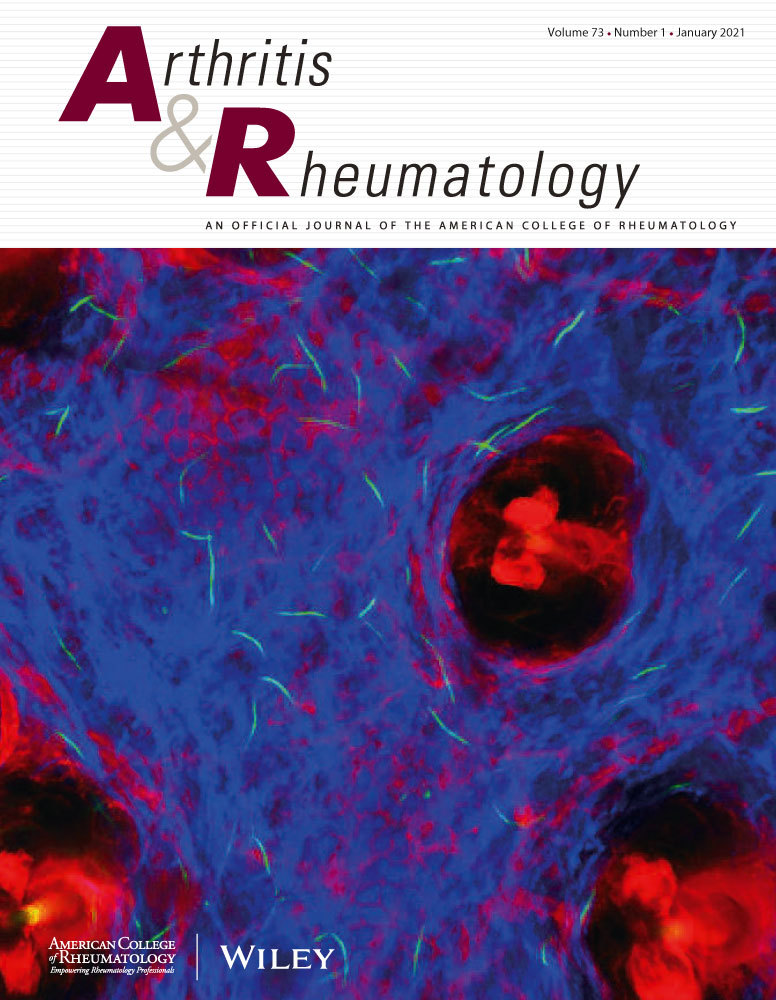C3a-C3aR1-mediated interactions between fibroblast-like synoviocytes and macrophages promote the progression of rheumatoid arthritis.
IF 10.9
1区 医学
Q1 RHEUMATOLOGY
引用次数: 0
Abstract
The inflammatory microenvironment in rheumatoid arthritis (RA) synovium is highly complex, comprising functional units known as cellular neighborhoods (CNs). However, how cell interactions within CNs shape the inflammatory microenvironment in RA remains unclear. Here, we utilized imaging mass cytometry (IMC) and single-cell RNA sequencing to dissect the CNs within RA synovium, uncovering critical cell-cell interactions and evaluating whether disrupting interaction signals could alleviate disease severity in collagen-induced arthritis (CIA) mouse model. Our findings revealed that CNs enriched with fibroblast-like synoviocytes (FLS) and immune cells, particularly FLS and macrophages, were more frequent in RA synovium compared to osteoarthritis (OA). Further single-cell RNA sequencing analysis showed that FLS specifically upregulated complement C3 while macrophages displayed high level of C3 receptor, C3aR1. Interestingly, C3a derived from FLS enhanced type I interferon response in macrophages, and blockade of the C3a-C3aR1 signaling reduced secretion of IFN-β in macrophages, thereby affecting FLS activation. Additionally, inhibition of C3a-C3aR1 signaling attenuated the severity of CIA mice with decreased immune cell infiltration, reduced FLS activation, and less bone destruction. Our study suggests that FLS promotes synovial inflammation via interaction with macrophages through a C3a-C3aR1 signaling-mediated positive feedback regulation. Thus, targeting C3a-C3aR1 signaling might provide a new therapeutic strategy for RA.c3a - c3ar1介导的成纤维细胞样滑膜细胞和巨噬细胞之间的相互作用促进类风湿关节炎的进展。
类风湿关节炎(RA)滑膜的炎症微环境是高度复杂的,由称为细胞邻域(CNs)的功能单元组成。然而,中枢神经系统内的细胞相互作用如何塑造类风湿关节炎的炎症微环境仍不清楚。在此,我们利用成像质细胞术(IMC)和单细胞RNA测序来解剖RA滑膜内的中枢神经网络,揭示关键的细胞-细胞相互作用,并评估破坏相互作用信号是否可以减轻胶原诱导关节炎(CIA)小鼠模型的疾病严重程度。我们的研究结果显示,与骨关节炎(OA)相比,中枢神经系统中富含成纤维细胞样滑膜细胞(FLS)和免疫细胞,特别是FLS和巨噬细胞,在RA滑膜中更常见。进一步的单细胞RNA测序分析表明,FLS特异性上调补体C3,而巨噬细胞显示高水平的C3受体C3aR1。有趣的是,源自FLS的C3a增强了巨噬细胞的I型干扰素反应,阻断C3a- c3ar1信号通路可减少巨噬细胞中IFN-β的分泌,从而影响FLS的激活。此外,C3a-C3aR1信号的抑制减轻了CIA小鼠的严重程度,减少了免疫细胞浸润,减少了FLS激活,减少了骨破坏。我们的研究表明,FLS通过C3a-C3aR1信号介导的正反馈调节,通过与巨噬细胞的相互作用促进滑膜炎症。因此,靶向C3a-C3aR1信号通路可能为RA提供新的治疗策略。
本文章由计算机程序翻译,如有差异,请以英文原文为准。
求助全文
约1分钟内获得全文
求助全文
来源期刊

Arthritis & Rheumatology
RHEUMATOLOGY-
CiteScore
20.90
自引率
3.00%
发文量
371
期刊介绍:
Arthritis & Rheumatology is the official journal of the American College of Rheumatology and focuses on the natural history, pathophysiology, treatment, and outcome of rheumatic diseases. It is a peer-reviewed publication that aims to provide the highest quality basic and clinical research in this field. The journal covers a wide range of investigative areas and also includes review articles, editorials, and educational material for researchers and clinicians. Being recognized as a leading research journal in rheumatology, Arthritis & Rheumatology serves the global community of rheumatology investigators and clinicians.
 求助内容:
求助内容: 应助结果提醒方式:
应助结果提醒方式:


